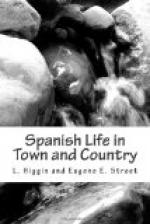Narvaez, the Queen of Ferdinand VII., Cristina, and
many other persons appear in the books, giving one
the impression that history is alive, and not the
record of long-dead actors we are accustomed to find
it. Galdos appears to despise any kind of plot;
the events run on, as they did in fact run on, only
there are one or two people who take part in them
whom we may suppose to be creations of the author’s
brain. Certainly, one learns more contemporary
history by reading these
Episodes of Perez
Galdos, and realises all the scenes of it much more
vividly than one would ever do by the reading of ordinary
records of events. As the tendency and the sympathy
of the writer is always Liberal, one fancies that
Galdos has written with the determined intention to
tempt a class of readers to become acquainted with
the recent history of their country who would never
do so under any less attractive form than that of
the novel. His works must do good, since they
are very widely read, and are extremely accurate as
history. His play,
Electra, which is just
now giving him such wide celebrity, is of the actual
time, and the scene is laid wholly in Madrid.
The freedom that he advocates for women is merely
that which Englishwomen have always enjoyed, or, at
least, since mediaeval times, and has nothing in common
with the emancipation which our “new women”
claim for themselves. Galdos, also, is fond of
introducing the simple-minded and honest, if not very
cultivated, priest. His style is pure, without
any great pretention to brilliancy, or any of the
straining after effect which so many of the English
writers seem to think gives distinction.
Pedro Alarcon is novelist first, and historian, poet,
and critic afterwards. That is to say, his novels
are his best-known and most widely read works.
He has two distinct styles. His Sombrero de
Tres Picos is a fascinating sketch of quaint old
village life, full of quiet grace, while El Escandalo
and La Prodiga are of the sensational order.
He writes, like Galdos, in series, such as Historietas
Nacionales, Narraciones Inverosimiles, and
Viajes por Espana. Parada is a native
of Santander, and writes of his beloved countrymen.
Sotilezas, his best-known, and perhaps best,
novel, treats of life among the fisher-folk of Santander,
before it became an industrial town. Writing
in dialect makes many of his stories puzzling, if not
impossible for foreign readers.
The lady who writes under the pseudonym of “Emelia
Pardo Bazan” may be said to be the leader or
the pioneer of women’s emancipation in the sense
in which we use the words. She is a native of
Galicia, and is imbued with that intense love of her
native province which distinguishes the people of
the mountains. Her novels are chiefly pictures
of its scenery and the life of its people, though
in at least one she does not hesitate to take her
readers behind the scenes of student life in Madrid.




